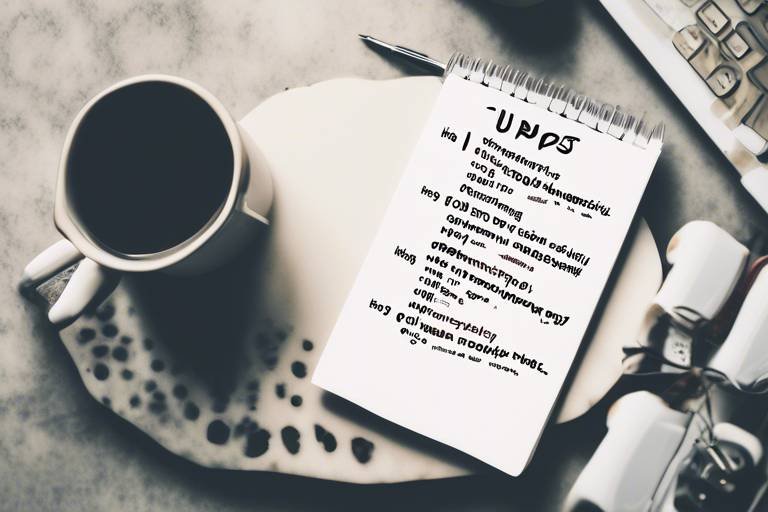How to Implement the 2-Minute Rule in Your Workflow
Implementing the 2-Minute Rule in your workflow can revolutionize the way you approach tasks and boost your productivity significantly. This rule, popularized by productivity expert David Allen, emphasizes the importance of completing quick tasks immediately rather than postponing them. By understanding and applying this simple yet powerful principle effectively, you can streamline your daily workflow and reduce procrastination.
When incorporating the 2-Minute Rule into your routine, it's essential to identify tasks that can be completed in 2 minutes or less. By sorting and categorizing activities based on their complexity and time requirements, you can prioritize effectively and ensure a seamless integration of the rule into your workflow. This proactive approach allows you to stay on top of your tasks and maintain momentum throughout the day.
Examples of 2-Minute tasks include responding to urgent emails, organizing files on your computer, or making quick phone calls. These small yet impactful activities demonstrate the versatility of the rule and showcase how addressing minor tasks promptly can lead to a more efficient work process overall.
Creating a structured 2-Minute Rule workflow involves setting realistic expectations and establishing a systematic approach to task management. By setting priorities, allocating specific time slots for quick tasks, and maintaining consistency in your routine, you can ensure that the rule becomes a sustainable and beneficial part of your daily workflow.
One of the key benefits of implementing the 2-Minute Rule is its ability to reduce mental clutter and enhance focus. By tackling small tasks promptly, you can free up mental space for more significant projects and maintain a clear sense of direction throughout your day. Embracing this rule can also foster a sense of accomplishment and motivation, leading to increased efficiency and improved time management skills.
As you integrate the 2-Minute Rule into your workflow, it's important to address common challenges that may arise, such as distractions, multitasking, or difficulty in estimating task duration. By implementing strategies to overcome these obstacles and staying committed to the principles of the rule, you can optimize your workflow and experience the full benefits of efficient task management.

Understanding the 2-Minute Rule
The 2-Minute Rule is a powerful productivity technique that can revolutionize the way you approach task management. Popularized by renowned productivity expert David Allen, this rule emphasizes the importance of tackling quick tasks immediately, regardless of their significance. By adhering to this principle, you can prevent small tasks from accumulating and overwhelming your to-do list.
At its core, the 2-Minute Rule is based on the idea that if a task can be completed in two minutes or less, it should be done without delay. This approach helps you maintain momentum in your workflow and prevents procrastination from creeping in. By swiftly addressing short tasks, you free up mental space and energy for more substantial projects.
Implementing the 2-Minute Rule requires a shift in mindset towards prioritizing efficiency and decisiveness. By identifying tasks that fall within the two-minute threshold, you can streamline your workflow and boost overall productivity. This rule serves as a practical tool for managing time effectively and staying on top of your responsibilities.

Identifying Quick Tasks
The 2-Minute Rule is a powerful tool for enhancing productivity and managing tasks efficiently. By identifying quick tasks that can be completed in a short amount of time, individuals can streamline their workflow and avoid procrastination. This rule, popularized by productivity expert David Allen, emphasizes the importance of tackling small tasks immediately, rather than postponing them.
When it comes to , it's essential to distinguish between activities that require minimal time and effort from those that are more complex. By categorizing tasks based on their estimated completion time, individuals can prioritize effectively and ensure that quick tasks do not get overlooked.
For example, tasks such as responding to short emails, organizing files, or scheduling brief meetings are prime candidates for the 2-Minute Rule. These activities can be completed swiftly and contribute to a sense of accomplishment, boosting motivation and momentum in one's workflow.
By recognizing quick tasks and incorporating them into a structured workflow, individuals can maximize their efficiency and minimize distractions. Setting aside dedicated time slots for these tasks and establishing a routine for their completion can lead to significant improvements in overall productivity.

Examples of 2-Minute Tasks
When it comes to implementing the 2-Minute Rule in your workflow, identifying quick tasks is essential for maximizing efficiency and productivity. These tasks are typically small, straightforward activities that can be completed in two minutes or less. By focusing on quick wins, you can build momentum and tackle larger projects with ease.
Examples of 2-Minute Tasks include responding to short emails, organizing your workspace, updating your to-do list, or making quick phone calls. These tasks may seem insignificant on their own, but collectively, they can have a significant impact on your overall productivity. By prioritizing these quick tasks, you can clear your plate for more substantial projects.
Imagine your workload as a puzzle, with each 2-Minute Task serving as a small puzzle piece. By fitting these pieces together efficiently, you can gradually complete the entire puzzle without feeling overwhelmed. These quick tasks act as building blocks for your productivity, helping you stay on track and accomplish more in less time.

Creating a 2-Minute Rule Workflow
Implementing the 2-Minute Rule into your workflow requires a systematic approach to ensure its effectiveness. By creating a structured workflow that incorporates this rule, you can streamline your task management process and boost productivity. This involves setting priorities, allocating specific time slots for quick tasks, and maintaining consistency in your routine.
One effective way to create a 2-Minute Rule workflow is to start your day by identifying and listing quick tasks that can be completed in 2 minutes or less. This initial step helps you visualize the small but essential activities that need immediate attention. By categorizing these tasks based on urgency or importance, you can efficiently tackle them throughout the day.
Additionally, establishing a designated time slot for addressing 2-minute tasks can prevent them from piling up and becoming overwhelming. Whether you prefer to handle them first thing in the morning or integrate them into your schedule at regular intervals, consistency is key to successfully implementing the rule.
Furthermore, incorporating the 2-Minute Rule into your workflow requires a balance between quick tasks and more complex projects. While quick wins can boost motivation and momentum, it's essential to allocate sufficient time for larger tasks that require deeper focus and concentration. By striking this balance, you can maximize your efficiency and overall productivity.

Setting Realistic Expectations
Setting realistic expectations when implementing the 2-minute rule is crucial for maintaining a balanced workflow. While the rule is effective for handling quick tasks efficiently, it's essential to understand its limitations and not overload yourself with unrealistic demands. By acknowledging the boundary of tasks that can be completed within 2 minutes, you can prevent burnout and ensure sustainable productivity.

Benefits of the 2-Minute Rule
Implementing the 2-Minute Rule in your workflow can bring a multitude of benefits that enhance your productivity and time management skills. One of the key advantages of this rule is its ability to reduce mental clutter. By promptly addressing quick tasks, you free up mental space that would otherwise be occupied by unfinished to-dos, allowing you to focus more effectively on important projects.
Furthermore, the 2-Minute Rule can help enhance your focus and concentration. By tackling small tasks immediately, you prevent them from lingering in the back of your mind and causing distractions. This focused approach enables you to devote more energy to complex or high-priority tasks, leading to improved overall performance.
Embracing the 2-Minute Rule also fosters a sense of accomplishment and motivation. Completing numerous quick tasks throughout the day provides a continuous stream of small victories, boosting your confidence and momentum. This sense of achievement can fuel your drive to tackle larger projects and goals with enthusiasm and determination.

Improving Time Management
Improving time management is a crucial aspect of personal productivity and efficiency. By incorporating the 2-minute rule into your workflow, you can enhance your ability to prioritize tasks and make the most of your time. This rule acts as a guiding principle, helping you quickly address small tasks that might otherwise accumulate and create mental clutter. By focusing on completing these quick tasks promptly, you free up mental space and energy for more substantial projects.
When implementing the 2-minute rule to improve time management, it's essential to establish a structured routine. Allocate specific time slots throughout your day dedicated to addressing quick tasks. By setting aside designated periods for these activities, you can prevent them from becoming overwhelming and disrupting your focus on larger projects. Consistency is key in developing a habit of efficiently managing your time.
Incorporating the 2-minute rule into your workflow also encourages you to become more mindful of task prioritization. By quickly identifying and completing short tasks, you create a sense of accomplishment that can motivate you to tackle more challenging projects. This approach helps you streamline your daily activities and minimize procrastination, leading to increased productivity and overall time management skills.

Overcoming Challenges
When implementing the 2-Minute Rule in your workflow, you may encounter various challenges that could hinder your productivity. One common obstacle is the presence of distractions that can divert your attention away from quick tasks. It's essential to create a conducive work environment free from interruptions to ensure efficient completion of 2-minute tasks.
Another challenge to overcome is the temptation to multitask while applying the 2-Minute Rule. While it may seem efficient to juggle multiple tasks simultaneously, it often leads to decreased focus and quality of work. Stay focused on one task at a time to maximize the benefits of the rule.
Estimating the time required for each task accurately can also be a hurdle when implementing the 2-Minute Rule. Some activities may take longer than expected, causing delays in your workflow. Develop a better sense of time management by practicing task estimation and adjusting your approach as needed.
Moreover, staying motivated and consistent in adhering to the 2-Minute Rule can pose a challenge, especially when faced with repetitive or mundane tasks. Find ways to stay engaged and motivated, such as rewarding yourself after completing a series of quick tasks or incorporating breaks to prevent burnout.
To navigate these challenges effectively, establish strategies tailored to your work style and preferences. Experiment with different techniques, such as time-blocking, prioritization methods, or utilizing productivity tools to optimize your workflow and enhance task management.
Frequently Asked Questions
- What is the 2-Minute Rule?
The 2-Minute Rule is a productivity strategy that involves tackling tasks that can be completed in 2 minutes or less immediately, rather than postponing them. This rule aims to reduce procrastination and increase efficiency in task management.
- Who popularized the 2-Minute Rule?
The 2-Minute Rule was popularized by productivity expert David Allen. He introduced this concept in his book "Getting Things Done," emphasizing the importance of addressing quick tasks promptly to enhance overall productivity.
- How can I identify tasks suitable for the 2-Minute Rule?
You can identify tasks suitable for the 2-Minute Rule by assessing their complexity and time requirement. Tasks that can be completed swiftly without significant effort or time investment are ideal candidates for immediate execution under this rule.
- What are the benefits of implementing the 2-Minute Rule?
Implementing the 2-Minute Rule can help reduce mental clutter, improve focus, and create a sense of accomplishment. By efficiently handling quick tasks, individuals can enhance their time management skills and overall productivity.
- How can I overcome challenges when applying the 2-Minute Rule?
To overcome challenges when applying the 2-Minute Rule, it is essential to address distractions, avoid multitasking, and accurately estimate task durations. Developing strategies to stay focused and prioritize effectively can help optimize the workflow.


















